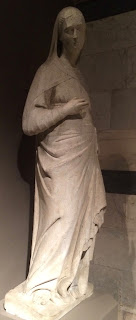Once we arrived (and found parking!) Siena, the six of us went separate ways. Ned and I purchased an OPI Si Pass (good for 3 days...) for 13 euros each and proceeded to "turbo tour" this amazing city.
First stop: Cattedrale (Duomo di Siena) where the marble mosaic floors are truly exquisite! The undertaking went from 14th to 16th centuries, and about 40 different artists contributed to the 56 panels that depict allegories, virtues, the sibyls, and scenes from the Old Testament. (Not sure where Socrates fits...). Our timing was fortunate as the uncovered floor can only be seen for six to ten weeks a year. Otherwise most of these remarkable mosaics are covered over.


Designed and completed between 1215 and 1263, the cattedrale is distinguished by its greenish-black and white striped marble (with some red marble on the façade).
Second stop: The Libreria Piccolomini, that adjoins the cattedrale. Reminiscent of the Rila Monastery outside Sofia, Bulgaria, this was my #1 most favorite because of the calligraphy, which, because they are behind glass do not photograph well.




Hopefully, I was at least able to glean the gist...
 The frescos in this room are also amazingly stunning!
The frescos in this room are also amazingly stunning! 
Third stop (on the turbo tour) was the Museo dell'Opera, which houses works of art and architectural fragments that were formerly in, or a part of, the Duomo of Siena.
 |
| Donatello's Madonna and Child (ca. 1457) |
As we were on a turbo tour, we did not go upstairs to the actual Opera House, nor did we climb the stairs to the Panorama del Facciatone. We also opted to skip the crypts (Ned quote: "We have seen crypts before, and once you've seen one crypt...").
We did happen-stance upon a delightful little chapel: Chiesa di San Niccolo in Sasso.
We then popped around to the Battistero (baptismal), also part of the Duomo complex.
Note: We are going to have to visit the chiropractor upon my return home - for all the ceiling gawking we have done the past two weeks!
Final stop on the turbo tour was back to Il Campo,...

and the Fonte Gaia. Water was scarce in medieval Siena and its availability to the people of the commune changed lives. It took eight years to build the conduit to bring the water here, finally accomplished in 1343.
Ned and I then met our friends and began the hot walk back to the car...
but not before...





























No comments:
Post a Comment